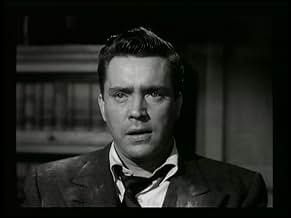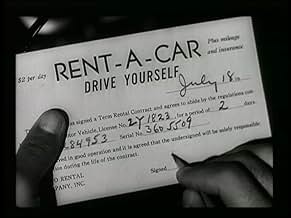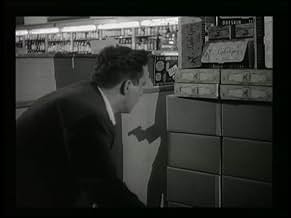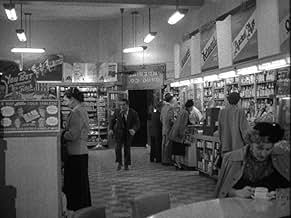CALIFICACIÓN DE IMDb
7.2/10
14 k
TU CALIFICACIÓN
Frank Bigelow, al que han envenenado y le quedan pocos días de vida, intenta averiguar quién le ha matado y por qué.Frank Bigelow, al que han envenenado y le quedan pocos días de vida, intenta averiguar quién le ha matado y por qué.Frank Bigelow, al que han envenenado y le quedan pocos días de vida, intenta averiguar quién le ha matado y por qué.
- Dirección
- Guionistas
- Elenco
- Premios
- 2 premios ganados en total
Beverly Garland
- Miss Foster
- (as Beverly Campbell)
Cay Forester
- Sue
- (as Cay Forrester)
Frank Jaquet
- Dr. Matson
- (as Fred Jaquet)
Lawrence Dobkin
- Dr. Schaefer
- (as Larry Dobkin)
Bill Baldwin
- St. Francis Hotel Desk Clerk
- (sin créditos)
Opiniones destacadas
Frank Bigelow: "I want to report a murder." Homicide Captain: "Where was this murder committed?" Frank Bigelow: "San Francisco, last night." Homicide Captain: "Who was murdered?" Frank Bigelow: "I was."
It must be the dream of all directors to open a film with a scene or line which carries great impact and remains in the memory. The opening line in D.O.A must rank among the most dramatically effective and intriguing lines that has ever opened a movie. This is the quintessential film noir. Edmond O'Brien as the tough, hard drinking businessman who has grown tired of the normalcy of his life and the clinging Paula. His holiday in San Francisco is an opportunity to break the shackels. The premise that the hero has been given a slow poison for which there is no cure, and only a day or so to solve his own murder before he dies, is exceptional. We also have an array of sultry "bad girls", a seedy villain and a manic hitman. Rudoph Mate directs brilliantly, not missing a moment to twist and turn the action at a fast pace with no dull moments. Scenes of O'Brien running through city streets after he has learned his fate are superb with incredibly realistic wide shots. The fact that his direction is so effective makes one wonder how he could have allowed the lapses of ridiculous canned "wolf whistles" whenever the hero passed a good looking girl in the early scenes. Although these "wolf whistles" are really out of place and very annoying, the film is so effective that we can forgive the indiscretion. This is a classic example of a brilliant plot superbly told in a way that is still gripping 50 years after it was made. D.O.A. defines Film Noir.
It must be the dream of all directors to open a film with a scene or line which carries great impact and remains in the memory. The opening line in D.O.A must rank among the most dramatically effective and intriguing lines that has ever opened a movie. This is the quintessential film noir. Edmond O'Brien as the tough, hard drinking businessman who has grown tired of the normalcy of his life and the clinging Paula. His holiday in San Francisco is an opportunity to break the shackels. The premise that the hero has been given a slow poison for which there is no cure, and only a day or so to solve his own murder before he dies, is exceptional. We also have an array of sultry "bad girls", a seedy villain and a manic hitman. Rudoph Mate directs brilliantly, not missing a moment to twist and turn the action at a fast pace with no dull moments. Scenes of O'Brien running through city streets after he has learned his fate are superb with incredibly realistic wide shots. The fact that his direction is so effective makes one wonder how he could have allowed the lapses of ridiculous canned "wolf whistles" whenever the hero passed a good looking girl in the early scenes. Although these "wolf whistles" are really out of place and very annoying, the film is so effective that we can forgive the indiscretion. This is a classic example of a brilliant plot superbly told in a way that is still gripping 50 years after it was made. D.O.A. defines Film Noir.
Great B-movie film noir, played as if his life depended on it (and it does) by Edmond O'Brien as a small-town notary who pays a big price for signing the wrong document at the wrong time, turning what should have been a pleasure trip to the west coast into a murderous affair altogether.
It starts with a bang, O'Brien staggering into the local homicide unit to tell the cops that there's been a murder - his, before launching into the massive flash-back which takes up pretty much the rest of the movie. The action from there on is hectic and as convoluted as all the best noirs are as O'Brien, infected by a deadly poison, races against the clock to track down his own killer and the reason behind it.
The film makes fine use of actual San Francisco and Los Angeles locations as well as authentically depicting the hot and steamy atmosphere at a Frisco jazz club. O'Brien is great as the doomed Bigelow, racing, often literally, against the clock, stopping only to palm off his adoring secretary girl-friend, Pamela Britten, who of course doesn't find out what's wrong with him until too late.
The pacing is almost non-stop once it gathers momentum, unfortunately when it does, some of the scene-writing gets over-ripe and correspondingly over-acted as O'Brien and his girl pour out their hearts somewhat unnecessarily. The film ends bravely though with a downbeat conclusion, delivering what the title says it must and at least tying up all the loose ends by that time.
It starts with a bang, O'Brien staggering into the local homicide unit to tell the cops that there's been a murder - his, before launching into the massive flash-back which takes up pretty much the rest of the movie. The action from there on is hectic and as convoluted as all the best noirs are as O'Brien, infected by a deadly poison, races against the clock to track down his own killer and the reason behind it.
The film makes fine use of actual San Francisco and Los Angeles locations as well as authentically depicting the hot and steamy atmosphere at a Frisco jazz club. O'Brien is great as the doomed Bigelow, racing, often literally, against the clock, stopping only to palm off his adoring secretary girl-friend, Pamela Britten, who of course doesn't find out what's wrong with him until too late.
The pacing is almost non-stop once it gathers momentum, unfortunately when it does, some of the scene-writing gets over-ripe and correspondingly over-acted as O'Brien and his girl pour out their hearts somewhat unnecessarily. The film ends bravely though with a downbeat conclusion, delivering what the title says it must and at least tying up all the loose ends by that time.
When I started watching all the film noirs I could find, I was a bit disappointed in this. However, after three viewings I now find it decent. It's nothing super, but certainly better than what I though at first. A big help is having a better print of the film. This is one of those movies that always had a poor VHS quality transfer and many times the same on DVD. Finding a good print is hard, although I finally got a decent one with this Killer Classic DVD set that includes this movie.
The story, like the print, is not always easy to follow, either, even though the premise is very simple. A man discovers he has been poisoned and there is no hope for recovery. Before he dies, he retraces his steps to find out who "murdered him" (even though he's still alive when saying that) and why.
The story gets a bit complicated. Like a Sherlock Holmes or Charlie Chan mystery, there are a number of suspects that keep popping up. Many of them are hard to figure.
This is an odd film noir for several quirky things in this movie. The lead character, "Frank Bigelow" (Edmund O'Brien), is strange and kind of stupid in the beginning. There are a half dozen of these dumb whistle-like wolf call sound-effects that come out every time he sees a pretty woman. It just doesn't fit in a tough film noir. Then there is his possessive girlfriend/secretary "Paula," (Pamela Britton) who is constantly calling him and paranoid about his whereabouts. She acts more like an insecure, nagging wife but she obviously cares a great deal about him. But, man, give the poor guy some space!
The dialog in this film ranges from incredibly stupid to very clever and solid film noir material.
We also see one of the most sadistic people I have ever seen on film: "Chester," played by the sadistic-looking Neville Brand. Wow, is this guy sick or what? He reminded me of "Vera" (Ann Savage) in "Detour." Those two would have made an interesting couple! Brand's character is only interested in one thing in life: inflicting pain and the slower and more brutal, the better.
Anyway, if you find a good print, tolerate some of the goofy things in the film, this is an interesting film noir that gets better with each viewing, as you understand the story better.
The story, like the print, is not always easy to follow, either, even though the premise is very simple. A man discovers he has been poisoned and there is no hope for recovery. Before he dies, he retraces his steps to find out who "murdered him" (even though he's still alive when saying that) and why.
The story gets a bit complicated. Like a Sherlock Holmes or Charlie Chan mystery, there are a number of suspects that keep popping up. Many of them are hard to figure.
This is an odd film noir for several quirky things in this movie. The lead character, "Frank Bigelow" (Edmund O'Brien), is strange and kind of stupid in the beginning. There are a half dozen of these dumb whistle-like wolf call sound-effects that come out every time he sees a pretty woman. It just doesn't fit in a tough film noir. Then there is his possessive girlfriend/secretary "Paula," (Pamela Britton) who is constantly calling him and paranoid about his whereabouts. She acts more like an insecure, nagging wife but she obviously cares a great deal about him. But, man, give the poor guy some space!
The dialog in this film ranges from incredibly stupid to very clever and solid film noir material.
We also see one of the most sadistic people I have ever seen on film: "Chester," played by the sadistic-looking Neville Brand. Wow, is this guy sick or what? He reminded me of "Vera" (Ann Savage) in "Detour." Those two would have made an interesting couple! Brand's character is only interested in one thing in life: inflicting pain and the slower and more brutal, the better.
Anyway, if you find a good print, tolerate some of the goofy things in the film, this is an interesting film noir that gets better with each viewing, as you understand the story better.
Fans of film noir should see this one, as this film is up there with the best.
It's a story about how a simple act can lead to disaster in this case, death. If you've not seen it, I'm not about to tell you much except this: it has perhaps the most imaginative beginning for any murder mystery ever devised as Frank Bigelow (Edmond O'Brien) fronts up to the Homicide Bureau in Los Angeles to report a murder his own! Thereafter, the story traces Frank's attempts to find out who is trying to kill him, and why. One of the best pieces of irony is when, having learnt that he will die soon, Frank runs and runs until he's out of breath and stops, panting, beside a newsstand where there are multiple copies of Life magazine hanging there, just beside him. The director, Rudolph Mate, had a real insider joke with that shot.
And that long tracking shot, by the way, was an excellent example of how to use fast camera work and great editing.
On another level, the movie very much fits the times vis-à-vis the portrayal of evil and where it leads: retribution is always just around the corner for those who transgress society, even if you think you're justified. When you see this movie, you'll know what I mean.
And, for the times, the acting was good, with a standout performance from Edmond O'Brien, and ably supported by the ever-competent Luther Adler (as Majak, the sharp dealer in stolen goods), and Neville Brand, as the psychopathic Chester. The rest of the cast was adequate. The only jarring note (no pun intended) are the peculiar and bizarre wolf-whistles (inserted by some demented sound engineer?) that accompany Frank Bigelow as he looks at women in his hotel at San Francisco. What was the director thinking of...?
That aside, it's a good, fast-paced action mystery that helped to keep the film noir genre very much alive. Have a go...
It's a story about how a simple act can lead to disaster in this case, death. If you've not seen it, I'm not about to tell you much except this: it has perhaps the most imaginative beginning for any murder mystery ever devised as Frank Bigelow (Edmond O'Brien) fronts up to the Homicide Bureau in Los Angeles to report a murder his own! Thereafter, the story traces Frank's attempts to find out who is trying to kill him, and why. One of the best pieces of irony is when, having learnt that he will die soon, Frank runs and runs until he's out of breath and stops, panting, beside a newsstand where there are multiple copies of Life magazine hanging there, just beside him. The director, Rudolph Mate, had a real insider joke with that shot.
And that long tracking shot, by the way, was an excellent example of how to use fast camera work and great editing.
On another level, the movie very much fits the times vis-à-vis the portrayal of evil and where it leads: retribution is always just around the corner for those who transgress society, even if you think you're justified. When you see this movie, you'll know what I mean.
And, for the times, the acting was good, with a standout performance from Edmond O'Brien, and ably supported by the ever-competent Luther Adler (as Majak, the sharp dealer in stolen goods), and Neville Brand, as the psychopathic Chester. The rest of the cast was adequate. The only jarring note (no pun intended) are the peculiar and bizarre wolf-whistles (inserted by some demented sound engineer?) that accompany Frank Bigelow as he looks at women in his hotel at San Francisco. What was the director thinking of...?
That aside, it's a good, fast-paced action mystery that helped to keep the film noir genre very much alive. Have a go...
DOA was made on the cusp of Edmond O'Brien's transition from leads to character roles and it may very well be his career part.
It's a cheaply made thriller and it shows in spots. But it more than makes up for it in originality of plot and the performances of a superb cast of players.
DOA involves nothing less than Edmond O'Brien solving his own murder. He's in some kind of business and as a sideline he makes a little extra money as a notary. He notarizes a bill of sale and in doing so is a witness to a piece of evidence that a man who was a party to the sale had no reason to commit suicide.
But the perpetrator doesn't slip O'Brien something fast acting like cyanide. No he gets something called luminescent poisoning which is slow acting, but irreversibly fatal if not caught within a few hours of ingesting. When he learns what happens, O'Brien has nothing to lose in his hunt for his own killer.
Best in the cast of supporting players without a doubt is Neville Brand who invades Lyle Bettger territory in playing a psychopathic thug in Luther Adler's employ. Adler himself is always good as are good girl Pamela Britton and bad girl Beverly Garland.
The film was made on a shoestring, but occasionally those films can prove worthwhile.
It's a cheaply made thriller and it shows in spots. But it more than makes up for it in originality of plot and the performances of a superb cast of players.
DOA involves nothing less than Edmond O'Brien solving his own murder. He's in some kind of business and as a sideline he makes a little extra money as a notary. He notarizes a bill of sale and in doing so is a witness to a piece of evidence that a man who was a party to the sale had no reason to commit suicide.
But the perpetrator doesn't slip O'Brien something fast acting like cyanide. No he gets something called luminescent poisoning which is slow acting, but irreversibly fatal if not caught within a few hours of ingesting. When he learns what happens, O'Brien has nothing to lose in his hunt for his own killer.
Best in the cast of supporting players without a doubt is Neville Brand who invades Lyle Bettger territory in playing a psychopathic thug in Luther Adler's employ. Adler himself is always good as are good girl Pamela Britton and bad girl Beverly Garland.
The film was made on a shoestring, but occasionally those films can prove worthwhile.
¿Sabías que…?
- TriviaThe scene in which Bigelow runs in panic through the streets after learning he has been poisoned was what is considered a 'stolen shot' where the pedestrians along the sidewalk had no idea a movie was being made and no warning that Edmond O'Brien would be plowing through them.
- ErroresAfter finding out who's in the photo, Bigelow leaves the photography studio and immediately starts getting shot at. He heads toward the factory (screen right) where the shots are supposed to be coming from, but all the shots being fired and ricocheting off the ground, pipe, barrel, etc. are coming from the other direction (screen left).
- Citas
[first lines]
Homicide Detective: Can I help you?
Frank Bigelow: I'd like to see the man in charge.
Homicide Detective: In here...
Frank Bigelow: I want to report a murder.
Homicide Captain: Sit down. Where was this murder committed?
Frank Bigelow: San Francisco, last night.
Homicide Captain: Who was murdered?
Frank Bigelow: I was.
- Créditos curiososThe end credits read "The medical facts in this motion picture are authentic. Luminous toxin is a descriptive term for an actual poison. Technical Adviser, Edward F. Dunne, M.D."
- Versiones alternativasAlso available in a colorized version.
- ConexionesEdited into Déjà-vu (2000)
Selecciones populares
Inicia sesión para calificar y agrega a la lista de videos para obtener recomendaciones personalizadas
- How long is D.O.A.?Con tecnología de Alexa
- What does D.O.A. stand for?
- Is this available on DVD?
Detalles
- Tiempo de ejecución1 hora 23 minutos
- Color
- Relación de aspecto
- 1.37 : 1
Contribuir a esta página
Sugiere una edición o agrega el contenido que falta

Principales brechas de datos
By what name was Con las horas contadas (1949) officially released in India in English?
Responda




































